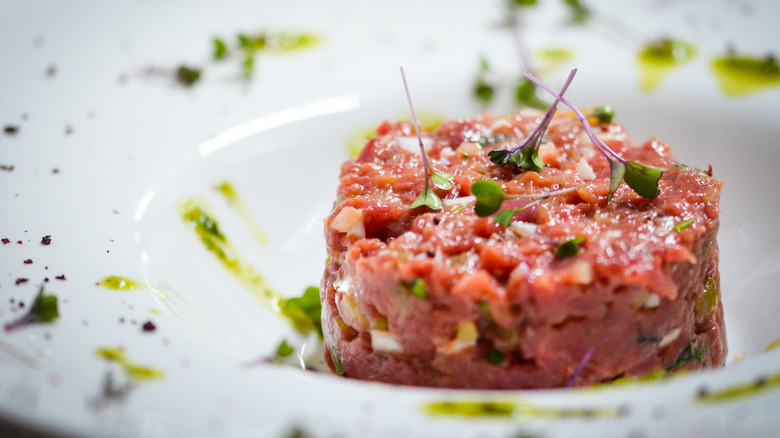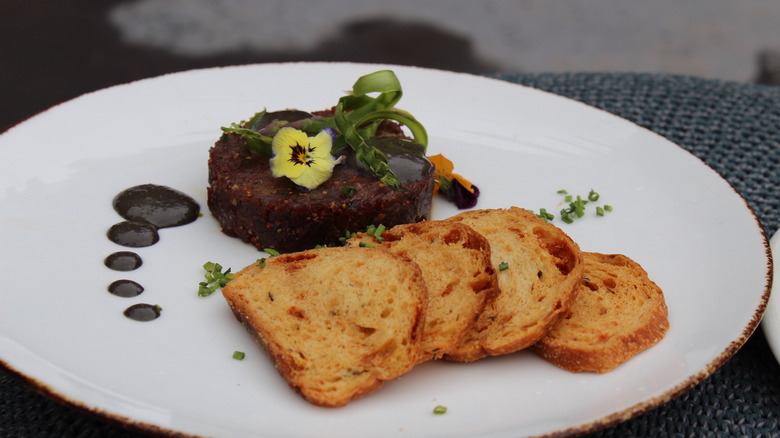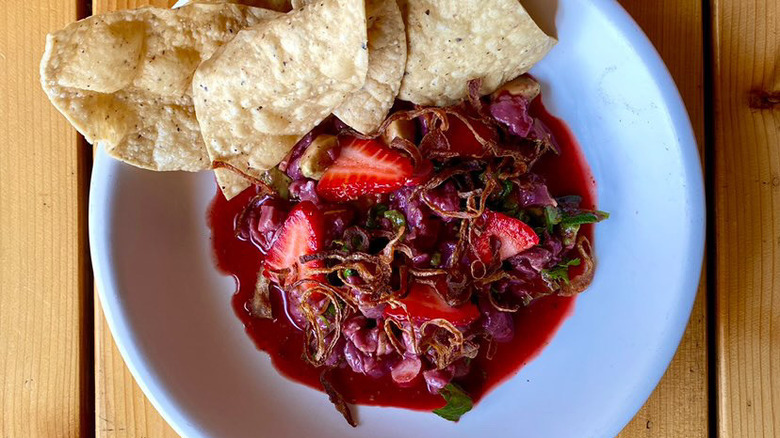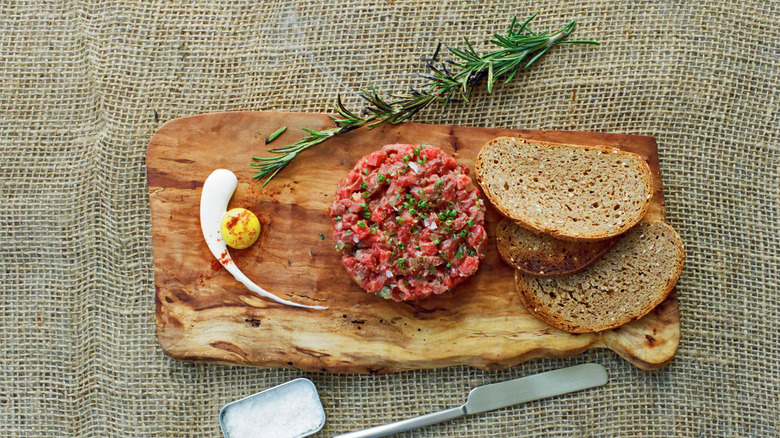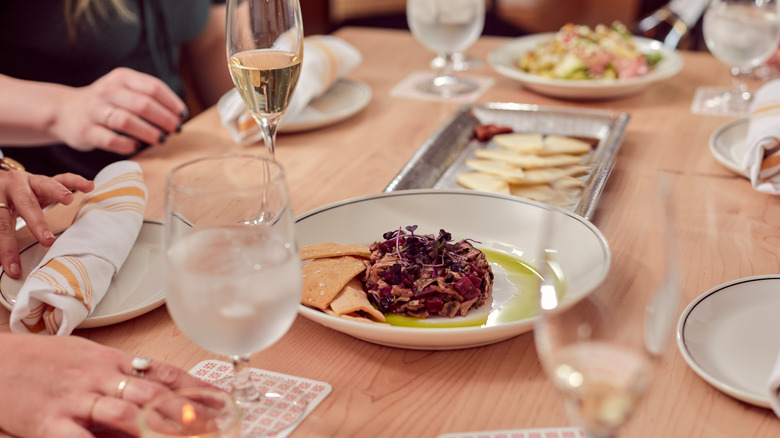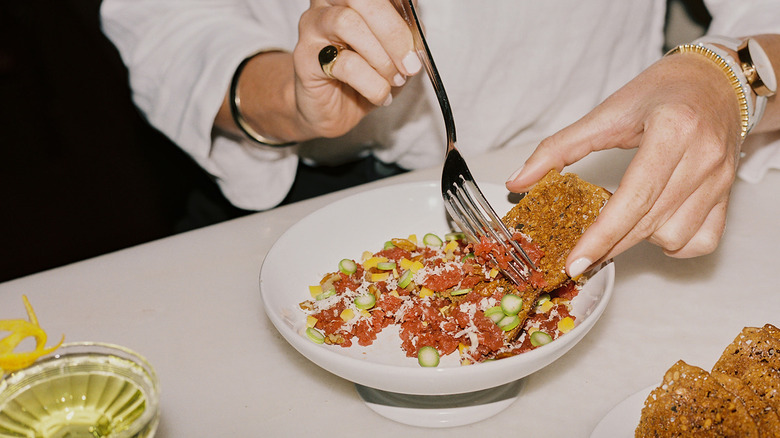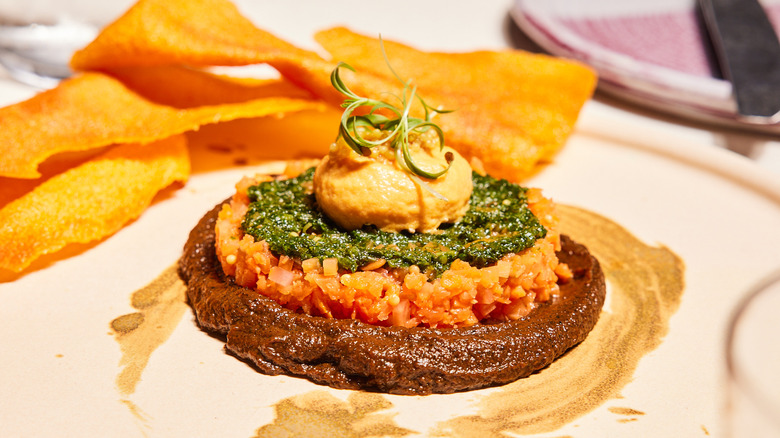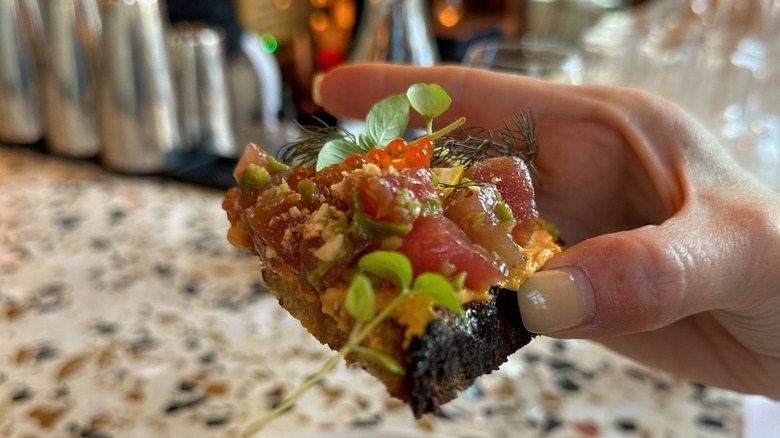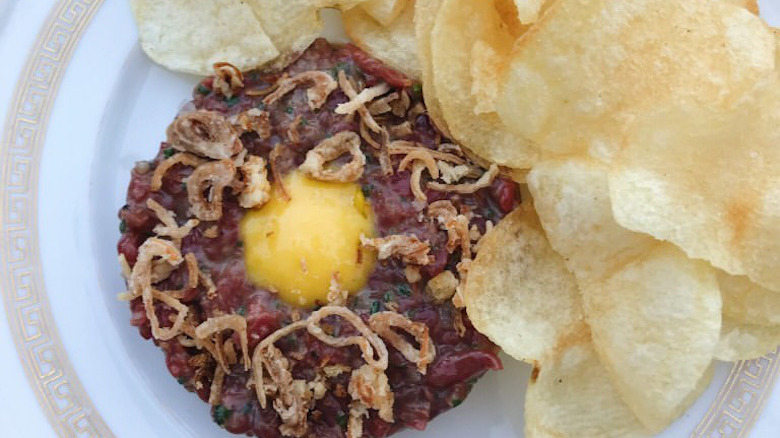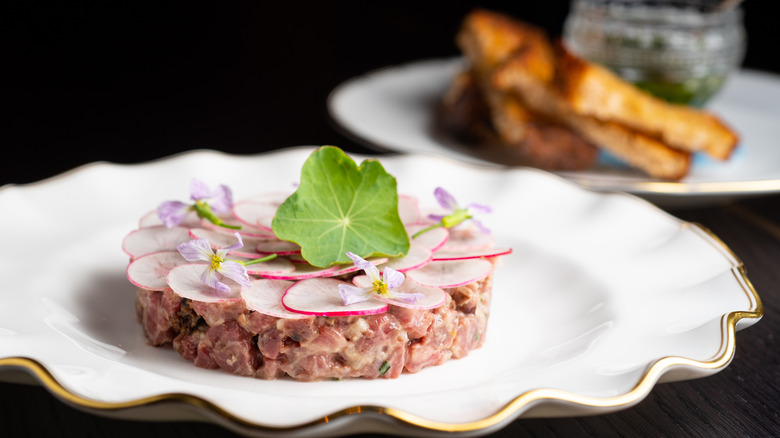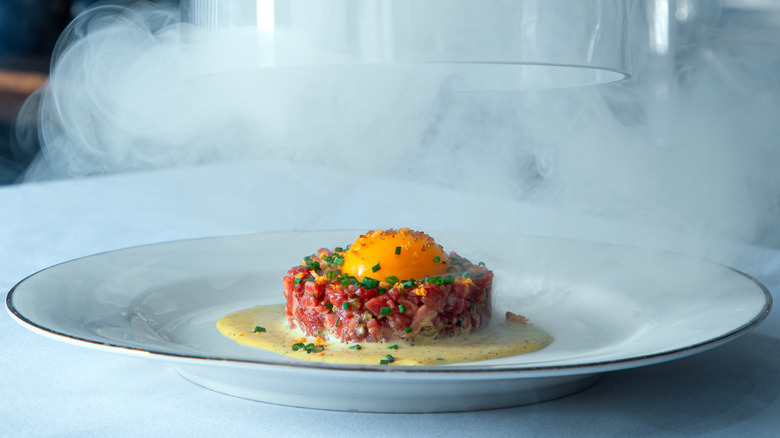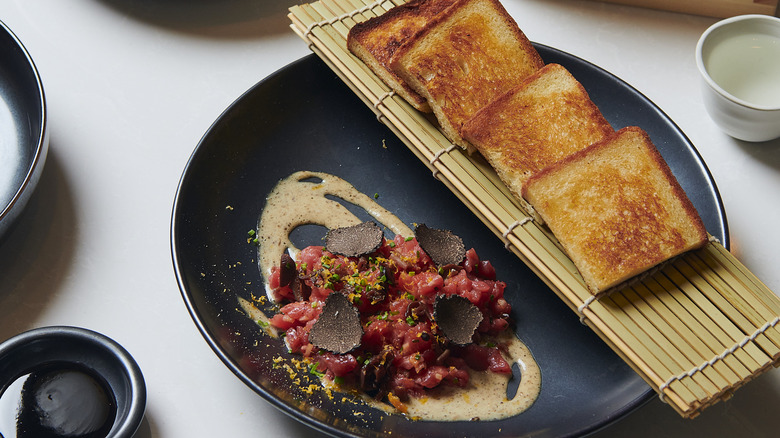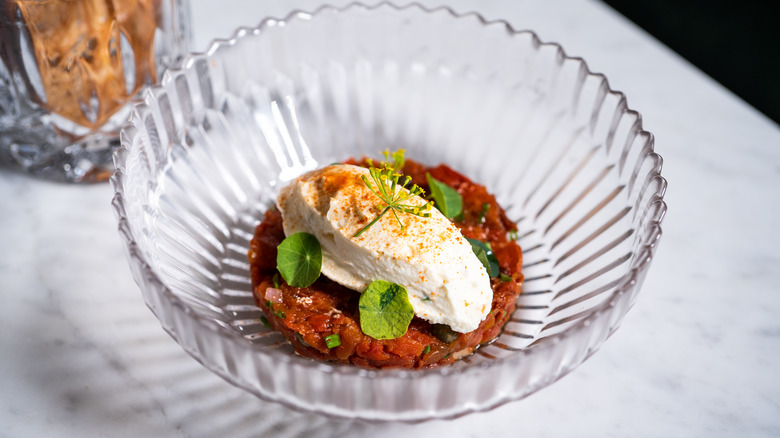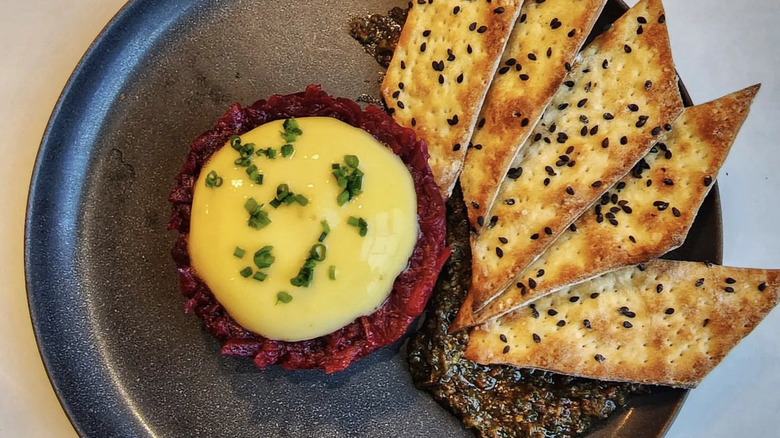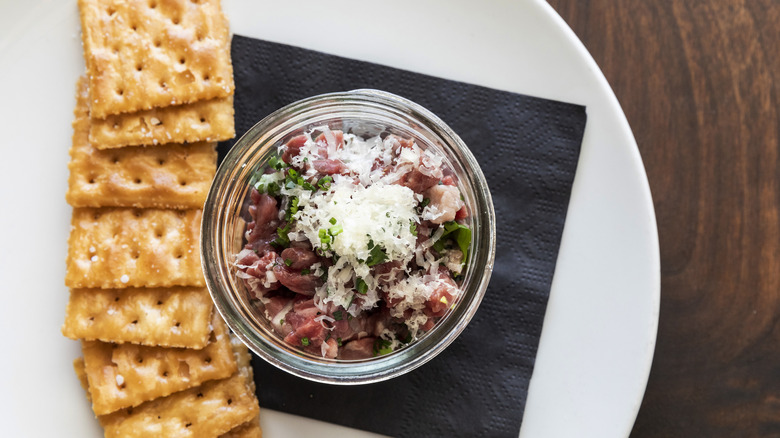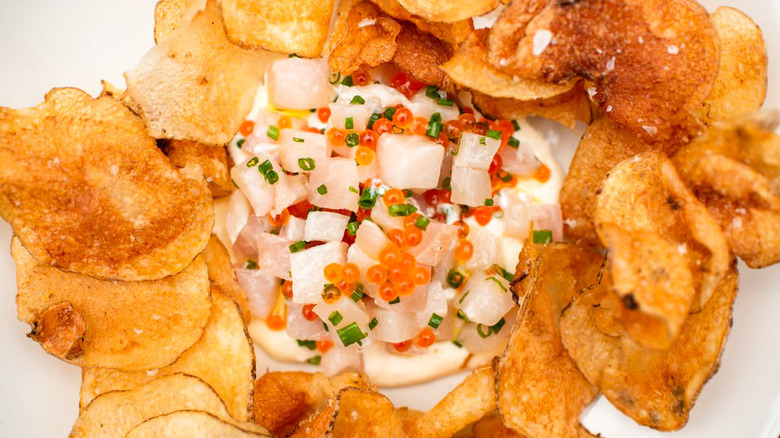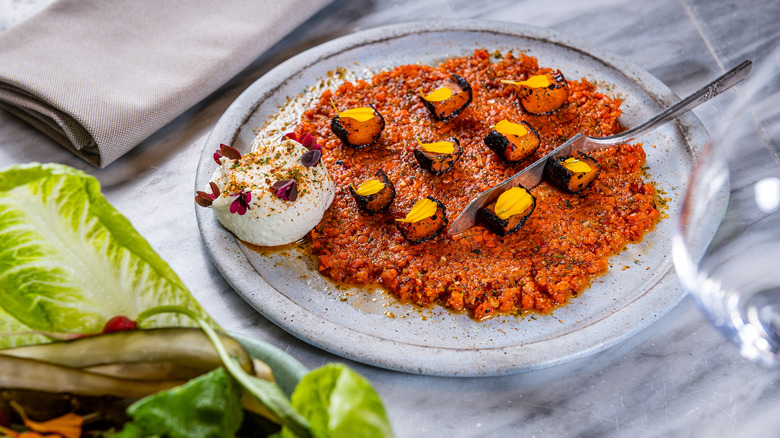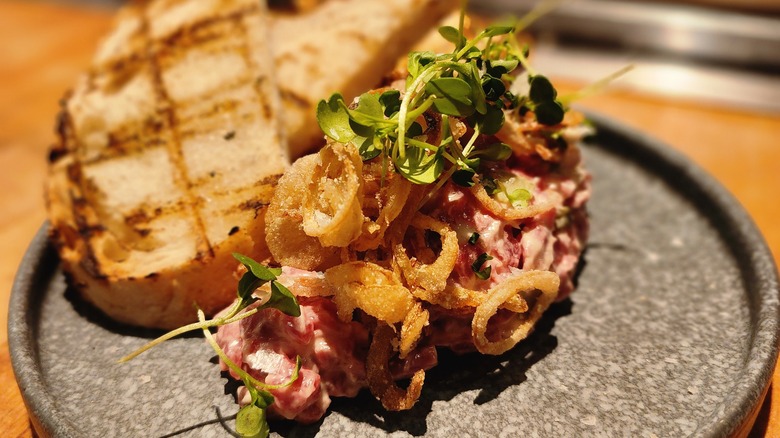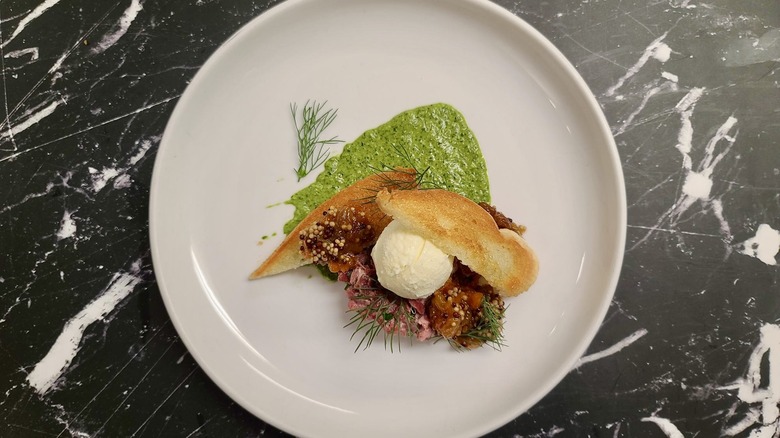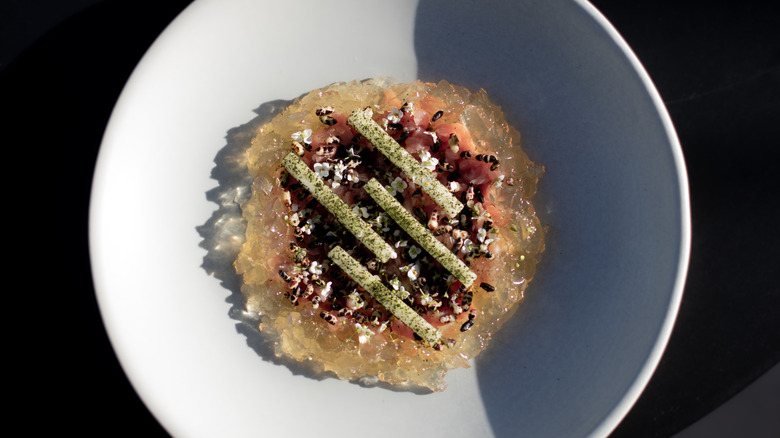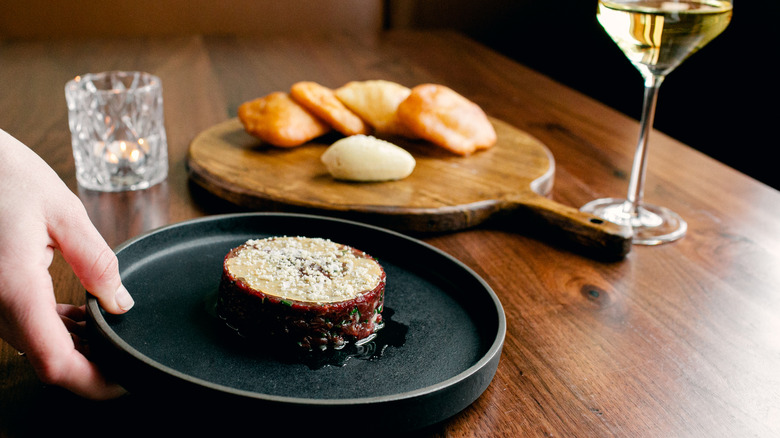20 Exceptional Tartare Dishes In The US
There's something innately pure and potent about tartare. Whether made from meat or seafood, it's a dish typically served raw, allowing the quality and texture of the ingredients to shine front and center. And aside from an aïoli or other sauce and, perhaps, some contrasting ingredients and garnishes, it's a dish that's often free of excess, allowing the freshness and purity of the protein to really pop. With this ethos as a guiding light, restaurants and chefs across the country have begun elevating their tartare creations of late, using the dish as a blank canvas for ingenuity and originality.
While traditional tartare fodder like steak and tuna are still common menu commodities, exciting new iterations have emerged across the country, rewriting the handbook of raw food "cookery" through a plethora of innovative techniques and atypical main ingredients. Nowadays, you're just as apt to find tartare made from carrots or mushrooms as you are beef, topped with all manner of accouterments and sauces, and often resented with pomp and circumstance. From tartare topped with Dijon ice cream to a surf-and-turf version that adds oysters to the party, we present 20 exceptional tartare dishes to try in U.S. restaurants.
New Mexican bison tartare at Terra in Santa Fe
One of the best restaurants in Santa Fe, Terra, is a place that takes local sourcing and regional ingredients seriously — and perhaps no dish on its ever-changing menu exemplifies this ethos like the New Mexican bison tartare.
It all starts with the main ingredient, the better-for-you protein bison, which isn't as gamey as one might think. Its naturally earthy flavor is mirrored by an aïoli pureed with huitlacoche, a corn fungus that's prized by chefs and packed with flavor, and an ingredient native to New Mexican and Mexican cuisines. An accompanying green chile cheddar crostini lends more New Mexican luster and a pleasant crunchy contrast, along with slivers of shaved asparagus.
Dry-aged Nilgai antelope tartare at Dai Due in Austin
In Texas, antelope is a common protein, beloved for its mild flavor, lean meat, and ability to thrive in the harsh South Texas environment (via Broken Arrow Ranch). Frequently found on menus in areas like Texas Hill Country, it's also a menu mainstay in Austin restaurants that emphasize local sourcing, such as Dai Due, which uses Nilgai antelope for various tartare treatments.
At any given moment, dry-aged antelope serves as the base for a wide array of colorful toppings and accompaniments. For spring, it's the foundation for a veritable bouquet of flavors, including a bright and floral strawberry-hibiscus aguachile, avocado, crispy threads of fried onion, and to scoop it all up, a few shards of corn tostadas fried in tallow.
Grass-fed steak tartare at Woods Hill Pier 4 in Boston
Sometimes simplicity and purity rule the day. When the ingredients are as fresh and diligently sourced as they are at Boston's Woods Hill Pier 4, a seasonally driven bastion of New England cuisine in the Seaport District, it's the simple dishes that shine the brightest and boldest. Case in point: a grass-fed steak tartare served with rosemary-tallow aïoli, crispy shallots, quail egg, and warm baguette.
While the ingredients and accompaniments may all sound classic, it's the thought and care that goes into each and every component that sets Woods Hill Pier 4 apart. That's thanks to a committed passion for farm-to-table sourcing from owner Kristin Canty and executive chef Charlie Foster, who supply much of their menu items from their own farm, The Farm at Woods Hill in Bath, New Hampshire. Most of the menu changes regularly but the tartare is a mainstay, thanks to that farm-fresh beef and the purity of its accompaniments, all served with a few slices of fresh bread.
Smoked mushroom tartare at Brother Fox in Pensacola
It turns out, one of the best — and boldest — tartare dishes in the U.S. can be found in an abandoned church. What once was a place of worship in Pensacola is now a newly minted boutique hotel, Lily Hall, home to Brother Fox restaurant from chef Darien Hernandez. And it's here where tartare eschews meat entirely for something else entirely.
Mushrooms are the star of the dish that are smoked and chopped into bite-sized morsels for optimal umami undertones that do a nice job replacing meat. Mixed with cubes of pickled beets, which add a complementary punch of earthiness and crunch, the vegetal tartare is sauced with a rich cashew crema and served with crisp and salty lavash crackers.
Lamb carne cruda at FIG in Charleston
At Charleston's venerable farm-to-table pioneer, Fig, local ingredients are the bread and butter — and it's also the key to enduring success for a restaurant that's been going strong since 2003. It's that commitment to seasonality and simplicity that's made Mike Lata's restaurant such an icon, as showcased in the purest of dishes, like lamb tartare.
While classic beef tartare makes regular menu appearances, nothing sings of spring-like Fig's lamb tartare. Dubbed lamb carne cruda, the current version features raw lamb mixed with pecorino, anchovy, and walnut, for a distinct medley of salty and earthy flavors. Depending on the season, said tartare occasionally comes with a bright truffle pesto, which is really the icing on the cake.
Carrot tartare at Walrus Rodeo in Miami
One of the best new restaurants in Miami is popular for good reason. Located in Little Haiti, Walrus Rodeo is a tiny 32-seater with grand ambitions and no shortage of playful, inventive fare sprawled across one of the most dynamic and wholly original menus in town. That means mushrooms come roasted in schmaltz, cabbage gets the carbonara treatment, and lasagna is made with mustard greens. It also means that carrots get the tartare treatment.
Taking an almost nose-to-tail approach to carrots, the dish features finely diced bright-orange carrots, along with carrot in every other conceivable form, including carrot top salsa verde, carrot espuma (aka foam), carrot chips, and carrot mole. Basically, this is likely the one tartare that would be equally appealing to foodies and rabbits.
Smoked yellowfin tuna tartine at Seabird in Wilmington, North Carolina
It was really only a matter of time before tartare got the tartine treatment. Such is the case at Seabird, chef Dean Neff's homage to coastal Carolina cuisine and all its bounty. One standout example on his locally sourced seafaring menu is his smoked yellowfin tuna tartare, served as a tartine and accented with a smattering of distinct and flavor-packed ingredients.
Ruby-hued yellowfin tuna, which is cold-smoked to add another layer of flavor before being diced into even cubes, is layered on thick slices of fresh and toasty housemade potato bread, along with some crunchy almond slivers, zesty olive salad, Meyer lemon, and the kicker: a smear of sweet potato skordalia, a sweeter riff on the traditionally garlicky Greek potato dip.
Steak tartare at Bistro La Floraison in Clayton, Missouri
Don't judge a book by its cover; what may look straightforward and familiarly classic, may very well have a lot more depth than one can perceive. That tends to be par for the course at Bistro La Floraison, an inventive brasserie and wine bar in the St. Louis-adjacent town of Clayton, where dishes like duck liver tart come with white verjus gelée, halibut features olive oil hollandaise, and even the classic-looking steak tartare doubles down on beef with bone marrow vinaigrette.
The steak tartare, which features meltingly tender cubes of raw beef, comes with a delicate and creamy steamed egg yolk, a pile of crispy shallots, and smoked bone marrow vinaigrette, providing an extra-meaty component that's known for its inherent richness and buttery quality. This uber-rich tartare can be scooped up via salt and vinegar potato chips, which are a nice tangy contrast to the notes of smoke and beef.
Tartare classique at Pasjoli in Santa Monica
Tartare is a menu mainstay on the always-changing menu at Pasjoli, Dave Beran's intimate temple of haute seasonal cuisine in Santa Monica. While the ingredients and garnishes may change steadily, beef tartare is always present in one way or another — and it's always a spectacle of vibrant seasonal flavors.
For its spring makeover, Beran employs two of his go-to ingredients for this time of year, radish and nasturtium, both of which provide pops of color and timely taste. Beef is lightly aged, then diced and served with Dijonnaise, raw shallots, horseradish, and lemon zest, then adorned with fried capers and chives. What takes it over the top is a layer of thinly sliced radishes, which are dressed in dry-aged beef fat, and an herbaceous finale from a nasturtium pesto.
Wagyu steak tartare at Bistro LeRoux in Denver
In many cases, steak tartare can serve as a base for classic flavors and fixtures like egg yolks, cornichons, and capers, while other times tartare can veer off wildly in more daring directions, such as a foundation for a deliciously audacious riff on surf and turf. The latter can be found at Bistro LeRoux, chef Lon Symensma's singular stamp on French bistro fare, where he serves steak tartare with a bit of flair.
It all starts with Wagyu steak, diced into tiny cubes and smoked with oak. Those smoky notes are echoed by a smoked oyster aïoli, which provides that surf and turf twist. A silky-smooth confit egg yolk sits on top, and the whole thing is presented under a glass cloche billowing with oak smoke. It's tartare with a bit more showmanship, served with cornichon and potato chips for crunch.
Steak tartare at Janken in Portland, Oregon
Steak tartare, in all its inherent meatiness and savoriness, has a natural affinity for the umami flavor profile. Described as having a deep, savory, meaty flavor, umami is commonly found in earthen ingredients like mushrooms and truffles, two potent items that lend themselves well to a particularly umami-packed tartare at Portland's Japanese-Korean fusion restaurant, Janken.
The beautifully presented dish features ruby-red steak tartare, blended with braised mushrooms and nestled on a fragrant bed of truffle aïoli. A few shaved black truffles round it out, and it's all served with a few slices of golden-milk bread toasted and presented on a bamboo sheet. Said toast is a welcome addition that serves to add a bit of soft crunch and some sweetness to counter all those savory umami notes.
Tomato tartare at Vol. 39 in Chicago
At Chicago's glam Vol. 39 cocktail bar inside the Kimpton Gray Hotel, customers can choose their own tartare adventure: They can go the classic route with tuna tartare or try something wildly atypical with the tomato tartare. A vegetarian riff that's just as lustrous as its meaty and nautical counterparts, it's a small plate that's big on flavor — without relying on beef or seafood as the main attraction.
The tartare itself, comprised of diced tomatoes that almost resemble steak tartare, provides a bright and vibrant base for shallots, chives, capers, and a plume of whipped goat cheese on top. A tad sweeter than standard tartares, tomato's natural sugars are well matched by those of the goat cheese, which provides a fluffy and creamy textural contrast as well. It's all gilded with some freshly snipped herbs and edible flowers, in case it wasn't pretty enough as is.
Beet tartare at Greenleaf in Milford, New Hampshire
Considering its proximity to foodie destinations like Maine and Boston, it's bizarre how overlooked New Hampshire is as a dining destination. Rich with abundant produce and soaked in maple syrup, this is a state that's wildly underrated for its cuisine — a sentiment exemplified deliciously at Greenleaf, a seasonally driven and locally sourced culinary gem in Milford, courtesy of chef Chris Viaud. While everything on his dynamic menu is a luscious homage to New Hampshire terroir, one dish that especially hits the nail on the head is his beet tartare.
The menu at Greenleaf is in a constant state of seasonal evolution, so diners always have fresh new dishes to savor, all of which utilize ingredients plucked from local farms. One such dish is Viaud's beet tartare, a meat-free version that swaps typical beef for earthy veggies, and then layers them with kaleidoscopic accompaniments like Mandarin orange foam, broccoli pesto, and housemade sesame crackers for crunch.
Medina County steak tartare at Wild Oats in Houston
At Wild Oats in the heart of the Houston Farmers Market, Texas cuisine is at once playful, singular, and well-traveled. In addition to serving one of the best chicken-fried steaks in the nation, the restaurant also serves steak another way — in tartare form — that's just as revelatory. Called the Medina County steak tartare, the dish is an homage to a traditional raw beef dish called parisa (via Texas Co-op Power), which originated in Medina County just outside of San Antonio.
As Wild Oats partner Nick Fine roved through Texas for menu inspiration, Medina County's unique tartare, a commonplace snack served in gas stations and deli counters, stood out as a must. The result is a tartare unlike anything in Houston, or any major city, made with hand-cut sirloin mixed with serrano vinaigrette, shallots, chives, and grated "Redneck" cheddar. It's all served with fried Saltines for a salty crunch.
Cobia tartare at The Optimist in Nashville
In terms of fish and seafood tartares, salmon and tuna are the most common menu fixtures, but at The Optimist in Nashville, one versatile white fish offers a sustainable alternative. Cobia, prized as a protein that stands up well to just about any cooking method or flavor profile, is the star of the tartare at the seasonally driven, sustainably minded restaurant that emphasizes seafood.
Along with other raw plates, like hamachi crudo and tuna poké, the cobia tartare features cubed white fish adorned with smoked trout roe, horseradish creme fraiche, and a smattering of salt and vinegar chips. The dish is a seasonal ode, when the cobia run into coastal waterways to spawn, providing an opportunity to showcase a fish known for its mild, buttery flavor and firm texture.
Smoked carrot kibbeh naya at Albi in Washington, D.C.
Tartare takes many forms — and many names — in cultures and cuisines across the globe. One version is kibbeh naya, a traditional Levantine dish that's made with raw meat (usually lamb) and frequently served in Mediterranean and Middle Eastern restaurants. At Albi in D.C., though, chef Michael Rafidi opts to spotlight seafood and vegetables for his kibbeh options, which rotate constantly throughout the seasons.
Currently, Rafidi features two kibbeh options: one with yellowfin tuna and a particularly striking option made with smoked carrots. The latter is a visual and flavorful stunner, featuring a bed of finely diced smoked carrots that bears a striking resemblance to lamb. It's topped with puffed bulgur for some earthy crunch, housemade garlic toum, mint and other morsels like housemade pickles, while lettuces allow guests to make their own smoky carrot wraps.
Surf and turf tartare at Shaker + Spear in Seattle
Located mere blocks from Elliott Bay in Seattle, a city that's revered for its fresh catch, it makes perfect sense that seafood would factor significantly into the tartare. Courtesy of chef Jay Donahue, the tartare du jour is a surf and turf combo that blends tradition with innovation, i.e. steak with oysters.
The tartare features New York strip steak from Double R Ranch, which provides a bit more fat than typical tenderloin. Inspired by its Pacific Northwest locale, it's topped with oyster emulsion, which lends an airy cloud of salinity and richness. Served with crispy shallots, cornichons, and housemade sourdough, it's a tartare that toes the line between classic and contemporary — and thanks to its indulgent combo of strip steak and oysters, a fresh spin on surf and turf.
Steak tartare at Bern's Steak House in Tampa
Dijon mustard is a frequent fixture that accompanies many a steak tartare. Typically, though, Dijon is relegated to a side condiment, or incorporated subtly into a blend of beef. It's not too often, then, that Dijon mustard is basically the star of the tartare — which is precisely the case at Tampa's venerable Bern's Steak House, where Dijon ice cream is one of the most unique tartare accompaniments in the country.
As classic and old-school as the longstanding restaurant may seem, Bern's Steak House is not without a few tricks up its sleeve. Case in point: this standout steak tartare from chef Chad Johnson, who tops his raw steak with herbs, buttery toast, and a whole dollop of Dijon ice cream, a daringly unique twist on tradition that provides a textural and temperature contrast like no other.
Veal tartare at Jeune et Jolie in Carlsbad, California
French cuisine combines with elegant Californian fare at Jeune et Jolie in the San Diego-adjacent city of Carlsbad. Here, chef Eric Bost features stunning dishes like ricotta gnudi, poisson, and Wagyu rib-eye, along with a striking starter plate of veal tartare.
A contemporary approach to tartare tradition, and a nod to both land and sea, the dish comes together by curing veal loins on kombu for 48 hours, imbuing the meat with salinity while deepening the natural richness of the meat. Diced and seasoned with green apples that have been compressed in white verjus, it's all accompanied by freshly grated wasabi, shoyu-marinated shallots, olive oil, lemon juice, puffed forbidden rice, and more green apple dusted with wakame seaweed. The grand finale? A dashi gelée infused with kombu, katsuobushi (aka dried bonito flakes), and dried mushrooms.
Elk tartare at The Nicolett in Lubbock, Texas
Game meats are common fodder for meaty menus throughout Texas, including at the gorgeous and contemporary American marvel that is The Nicolett. Located in the way-too-overlooked city of Lubbock, the glam restaurant traffics in modern Texan and American fare with an eye towards seasonality and optimal sourcing. A dish that typifies this ethos is the elk tartare, an item that's been a featured first course since opening day in 2020, and one that constantly changes iterations and accouterments.
Elk meat is prized for its varied flavors. The Ncolett sources from Broken Arrow Ranch in Texas Hill County. The current tartare version features a 28-day-aged elk leg filet that's seasoned with olive oil and charred tomatillo juice, adjoined by farm egg yolk, charred hatch chile, and pickled and roasted nopales for a fresh and fragrant west Texas take on tartare.
